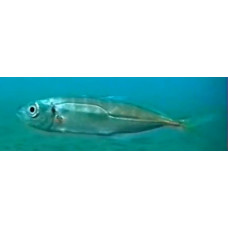Latin name
Trachurus mediterraneus
Other names
Black Sea horse mackerel, horse mackerel, Mediterranean scad, common scad, scad
Identification
The body is relatively low, rounded; its greatest height is 16.8-24.0% of body length to the end of the middle rays of the caudal fin. The lateral line is completely covered by bony scales. It has a large head and a protruding lower jaw. The nostrils are small and set close together, and the eyes are protected by a well-developed fatty eyelid. The fish has 36-41 gill blades and the anal fin is preceded by two distinct spines.
Features of fish fins
The last rays of the second dorsal and anal fins are almost not retired from remaining part of the fin; the distance between the bases of the last and penultimate rays of the anal fin is 1.1-1.3 times greater than the distance between the bases of the penultimate ray of this fin and the preceding ray (third posterior). The pectoral fins are relatively short, in adults not reaching the vertical of the base of the first anal fin ray or only slightly beyond it.
Fish colouring
The body is dark blue to grey with black on the back and top of the head, while the lower two-thirds of the body is white to silver. The caudal fin is yellow and there is a distinct black mark just behind the elytra.
Distribution
In the open Atlantic it is found from the Bay of Biscay in the north to Mauritania in the south. Through the Strait of Gibraltar it is widely distributed in the Mediterranean, hence its name. It permanently inhabits the Sea of Marmara, penetrates through the Bosporus into the Black Sea, where it is also quite common, and enters the Sea of Azov only at its southern and south-western edges. In the Black Sea itself, a rather small northern form up to 20 cm long and a large southern form up to 55 cm long are distinguished.
Habitat
Benthic-pelagic subtropical fish found at depths of 5 to 500 metres. An oceanodromous fish, usually found in marine waters but also in brackish waters.
Size
The fish reaches a maximum length of 60 cm, but specimens of 20-30 cm are much more common.
Behavior
Shoals at depths of 5m and more. Migrates within its home waters. Lives for about 14 years.
Food and feeding habits
A predatory fish that feeds on the juveniles of other pelagic fish such as European anchovy, sprattus, sand smelt, sand gerbil, Black Sea sprat, clupea, other juveniles and crustaceans (mysida, shrimps, amphipods, isopods).
Reproduction
It reproduces by laying eggs. Its reproductive cycle is divided into three distinct stages: pre-reproductive, reproductive and post-reproductive. The pre-reproductive stage lasts from January to April and the post-reproductive stage from September to December. During these periods, the sex glands are much smaller than during the reproductive stage. Mating takes place in the summer, from May to August, during which time the testes and ovaries increase greatly in size. The ovaries turn a dark orange colour and eggs are visible on the surface. Embryonic development takes place after 24-26 hours. The eggs are pelagic and 0.71-0.92 mm (0.028-0.036 in) long. Sexual maturity is reached at 2 years of age and is about 16 cm (6.3 in) long in both males and females.
Fishing
It is an important target for commercial and recreational fishing. It is sensitive to overfishing: it takes many years for numbers to recover, during which time the stock shrinks and rejuvenates.
| Classification | |
| Phylum | Chordata |
| Class | Actinopterygii |
| Squad | Carangiformes |
| Family | Carangidae |
| Genus | Trachurus |
| Species | T. mediterraneus |
| Features | |
| Conservation status | Least Concern |
| Habitat | Pelagic |
| Life span, years | 14 |
| Maximum body weight, kg | No information |
| Maximum length, cm | 60 |
| Sailing speed, m/s | No information |
| Threat to people | Edible |
| Way of eating | Predator |



